International Trade Theories and Reasons for Global Exchange
VerifiedAdded on 2023/01/12
|6
|888
|89
Homework Assignment
AI Summary
This assignment delves into the core concepts of international trade, addressing the fundamental question of why nations engage in trade with each other. It highlights the necessity of trade for countries lacking sufficient resources and emphasizes how international trade fosters financial stability and market growth. The assignment also summarizes key theories explaining trade flows, categorizing them into classical country-based theories and modern firm-based theories. Classical theories, including mercantilism, absolute advantage, comparative advantage, and factor proportion theory, are explained with examples. The document provides a concise explanation of each theory, illustrating how they contribute to understanding the dynamics of international trade and the exchange of goods and services between nations. The assignment uses examples to explain the concepts.
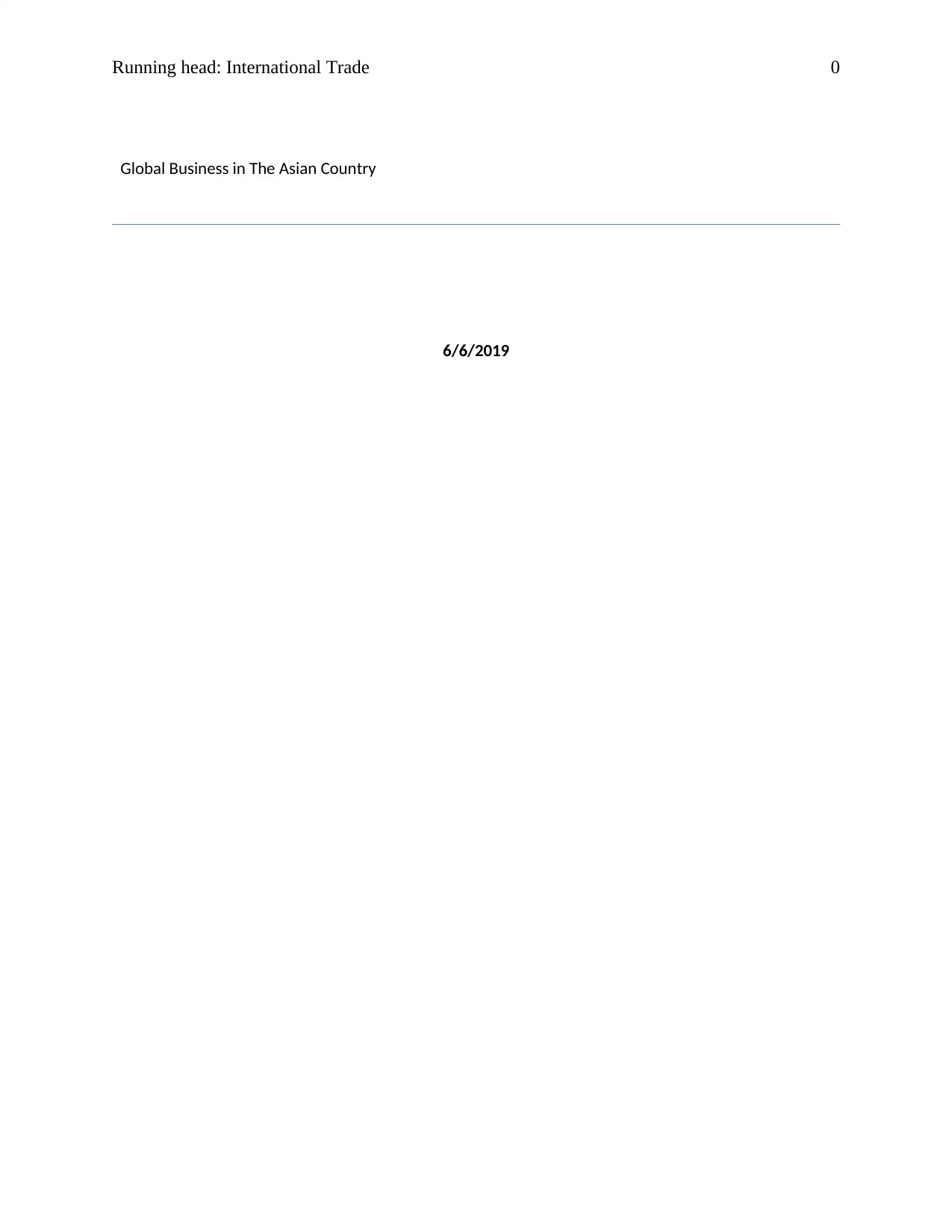
Running head: International Trade 0
Global Business in The Asian Country
6/6/2019
Global Business in The Asian Country
6/6/2019
Paraphrase This Document
Need a fresh take? Get an instant paraphrase of this document with our AI Paraphraser
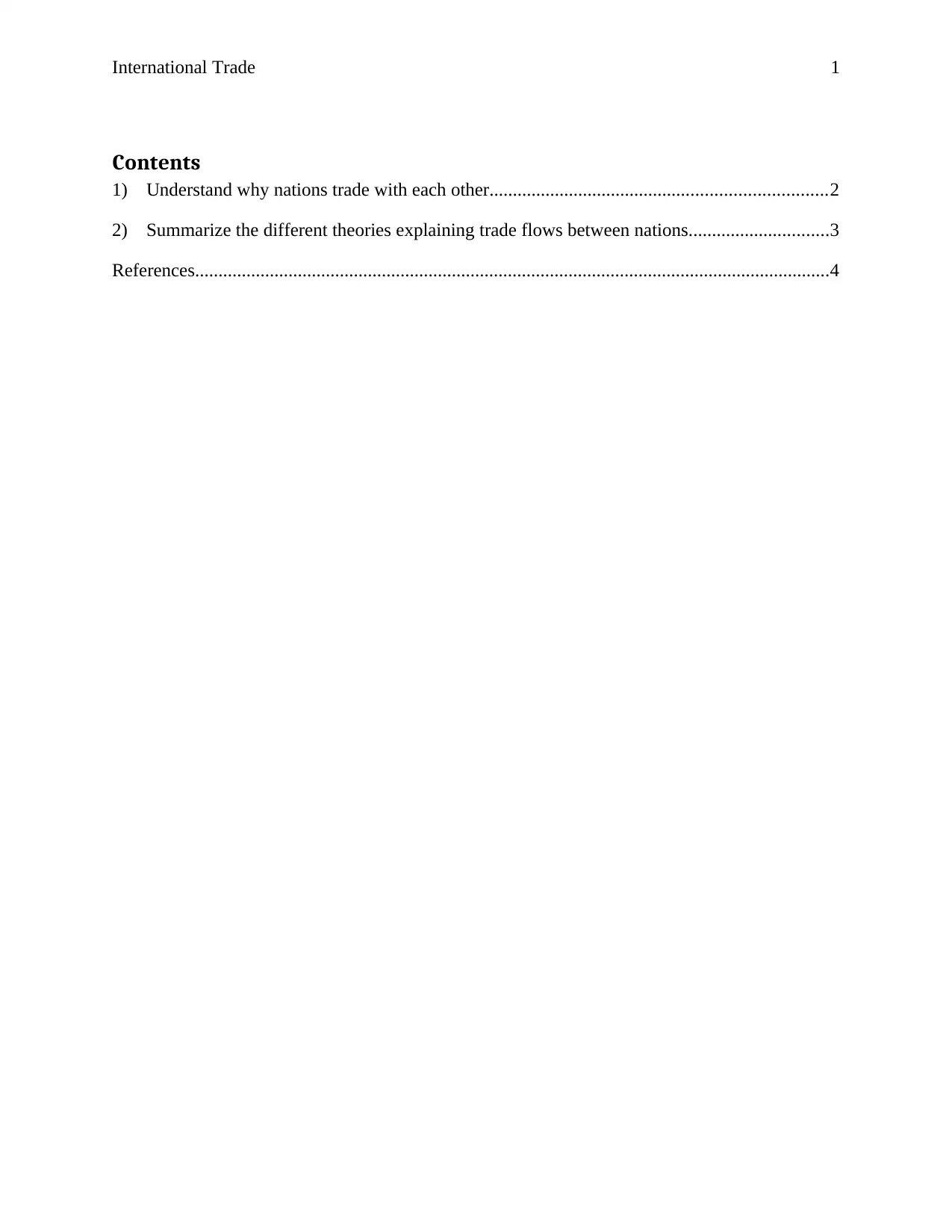
International Trade 1
Contents
1) Understand why nations trade with each other........................................................................2
2) Summarize the different theories explaining trade flows between nations..............................3
References........................................................................................................................................4
Contents
1) Understand why nations trade with each other........................................................................2
2) Summarize the different theories explaining trade flows between nations..............................3
References........................................................................................................................................4
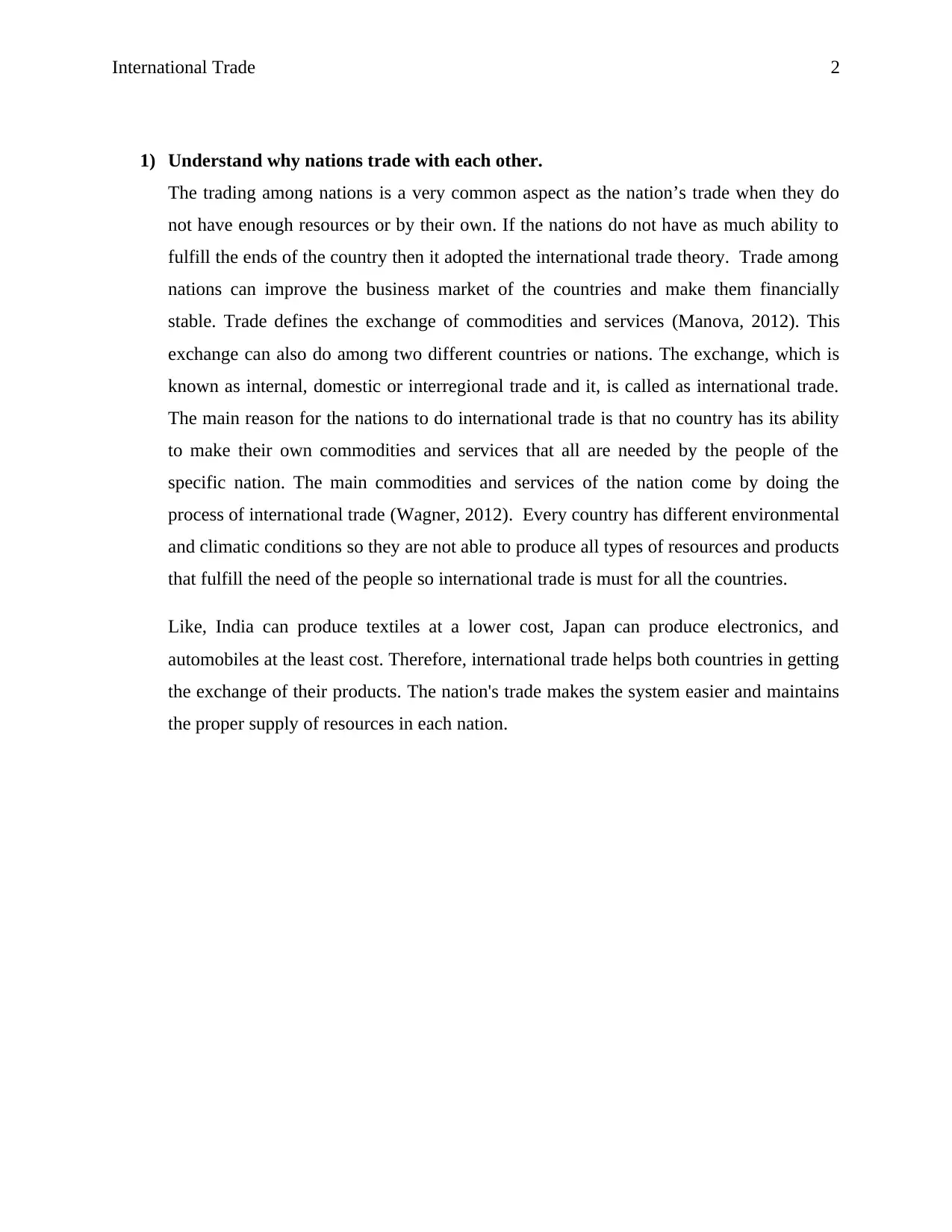
International Trade 2
1) Understand why nations trade with each other.
The trading among nations is a very common aspect as the nation’s trade when they do
not have enough resources or by their own. If the nations do not have as much ability to
fulfill the ends of the country then it adopted the international trade theory. Trade among
nations can improve the business market of the countries and make them financially
stable. Trade defines the exchange of commodities and services (Manova, 2012). This
exchange can also do among two different countries or nations. The exchange, which is
known as internal, domestic or interregional trade and it, is called as international trade.
The main reason for the nations to do international trade is that no country has its ability
to make their own commodities and services that all are needed by the people of the
specific nation. The main commodities and services of the nation come by doing the
process of international trade (Wagner, 2012). Every country has different environmental
and climatic conditions so they are not able to produce all types of resources and products
that fulfill the need of the people so international trade is must for all the countries.
Like, India can produce textiles at a lower cost, Japan can produce electronics, and
automobiles at the least cost. Therefore, international trade helps both countries in getting
the exchange of their products. The nation's trade makes the system easier and maintains
the proper supply of resources in each nation.
1) Understand why nations trade with each other.
The trading among nations is a very common aspect as the nation’s trade when they do
not have enough resources or by their own. If the nations do not have as much ability to
fulfill the ends of the country then it adopted the international trade theory. Trade among
nations can improve the business market of the countries and make them financially
stable. Trade defines the exchange of commodities and services (Manova, 2012). This
exchange can also do among two different countries or nations. The exchange, which is
known as internal, domestic or interregional trade and it, is called as international trade.
The main reason for the nations to do international trade is that no country has its ability
to make their own commodities and services that all are needed by the people of the
specific nation. The main commodities and services of the nation come by doing the
process of international trade (Wagner, 2012). Every country has different environmental
and climatic conditions so they are not able to produce all types of resources and products
that fulfill the need of the people so international trade is must for all the countries.
Like, India can produce textiles at a lower cost, Japan can produce electronics, and
automobiles at the least cost. Therefore, international trade helps both countries in getting
the exchange of their products. The nation's trade makes the system easier and maintains
the proper supply of resources in each nation.
⊘ This is a preview!⊘
Do you want full access?
Subscribe today to unlock all pages.

Trusted by 1+ million students worldwide
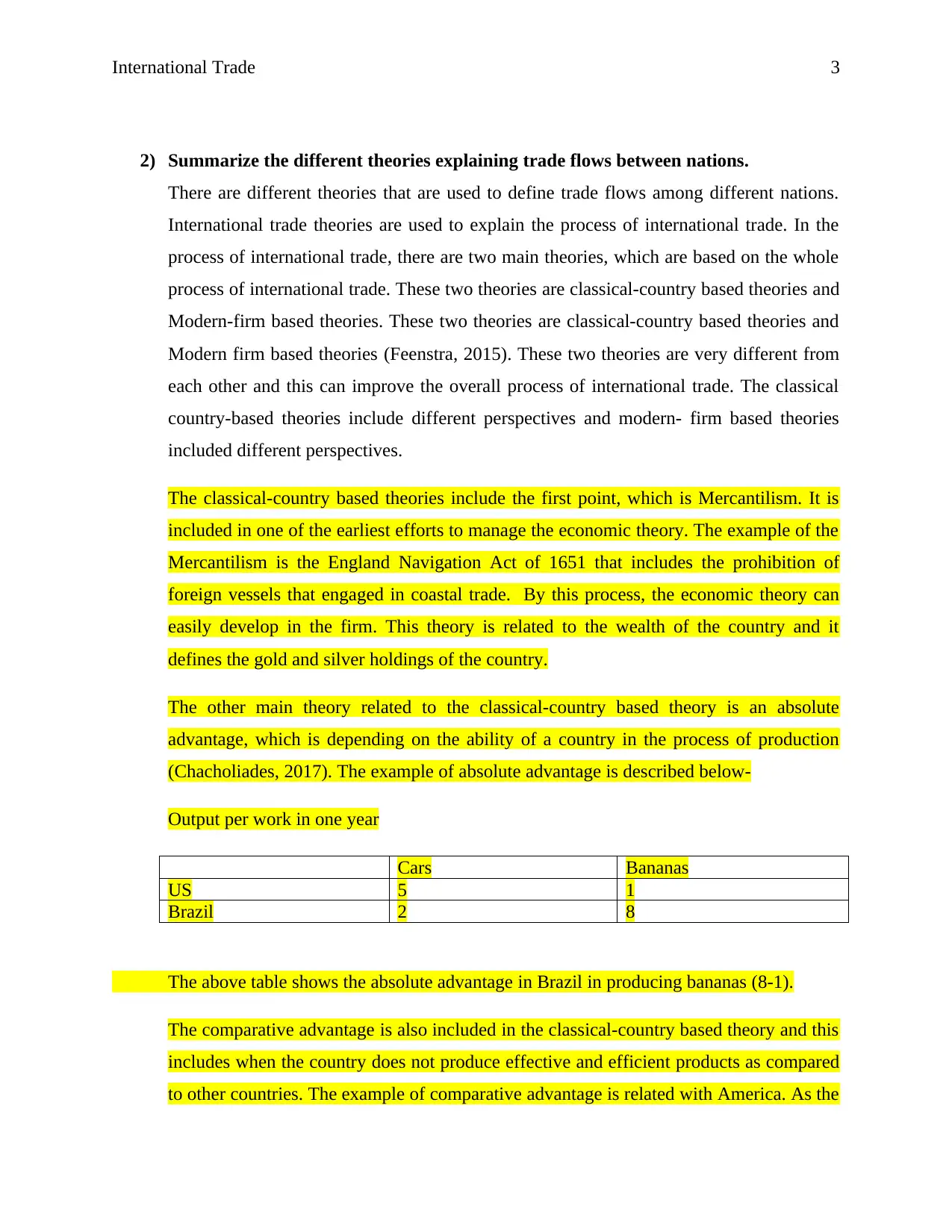
International Trade 3
2) Summarize the different theories explaining trade flows between nations.
There are different theories that are used to define trade flows among different nations.
International trade theories are used to explain the process of international trade. In the
process of international trade, there are two main theories, which are based on the whole
process of international trade. These two theories are classical-country based theories and
Modern-firm based theories. These two theories are classical-country based theories and
Modern firm based theories (Feenstra, 2015). These two theories are very different from
each other and this can improve the overall process of international trade. The classical
country-based theories include different perspectives and modern- firm based theories
included different perspectives.
The classical-country based theories include the first point, which is Mercantilism. It is
included in one of the earliest efforts to manage the economic theory. The example of the
Mercantilism is the England Navigation Act of 1651 that includes the prohibition of
foreign vessels that engaged in coastal trade. By this process, the economic theory can
easily develop in the firm. This theory is related to the wealth of the country and it
defines the gold and silver holdings of the country.
The other main theory related to the classical-country based theory is an absolute
advantage, which is depending on the ability of a country in the process of production
(Chacholiades, 2017). The example of absolute advantage is described below-
Output per work in one year
Cars Bananas
US 5 1
Brazil 2 8
The above table shows the absolute advantage in Brazil in producing bananas (8-1).
The comparative advantage is also included in the classical-country based theory and this
includes when the country does not produce effective and efficient products as compared
to other countries. The example of comparative advantage is related with America. As the
2) Summarize the different theories explaining trade flows between nations.
There are different theories that are used to define trade flows among different nations.
International trade theories are used to explain the process of international trade. In the
process of international trade, there are two main theories, which are based on the whole
process of international trade. These two theories are classical-country based theories and
Modern-firm based theories. These two theories are classical-country based theories and
Modern firm based theories (Feenstra, 2015). These two theories are very different from
each other and this can improve the overall process of international trade. The classical
country-based theories include different perspectives and modern- firm based theories
included different perspectives.
The classical-country based theories include the first point, which is Mercantilism. It is
included in one of the earliest efforts to manage the economic theory. The example of the
Mercantilism is the England Navigation Act of 1651 that includes the prohibition of
foreign vessels that engaged in coastal trade. By this process, the economic theory can
easily develop in the firm. This theory is related to the wealth of the country and it
defines the gold and silver holdings of the country.
The other main theory related to the classical-country based theory is an absolute
advantage, which is depending on the ability of a country in the process of production
(Chacholiades, 2017). The example of absolute advantage is described below-
Output per work in one year
Cars Bananas
US 5 1
Brazil 2 8
The above table shows the absolute advantage in Brazil in producing bananas (8-1).
The comparative advantage is also included in the classical-country based theory and this
includes when the country does not produce effective and efficient products as compared
to other countries. The example of comparative advantage is related with America. As the
Paraphrase This Document
Need a fresh take? Get an instant paraphrase of this document with our AI Paraphraser
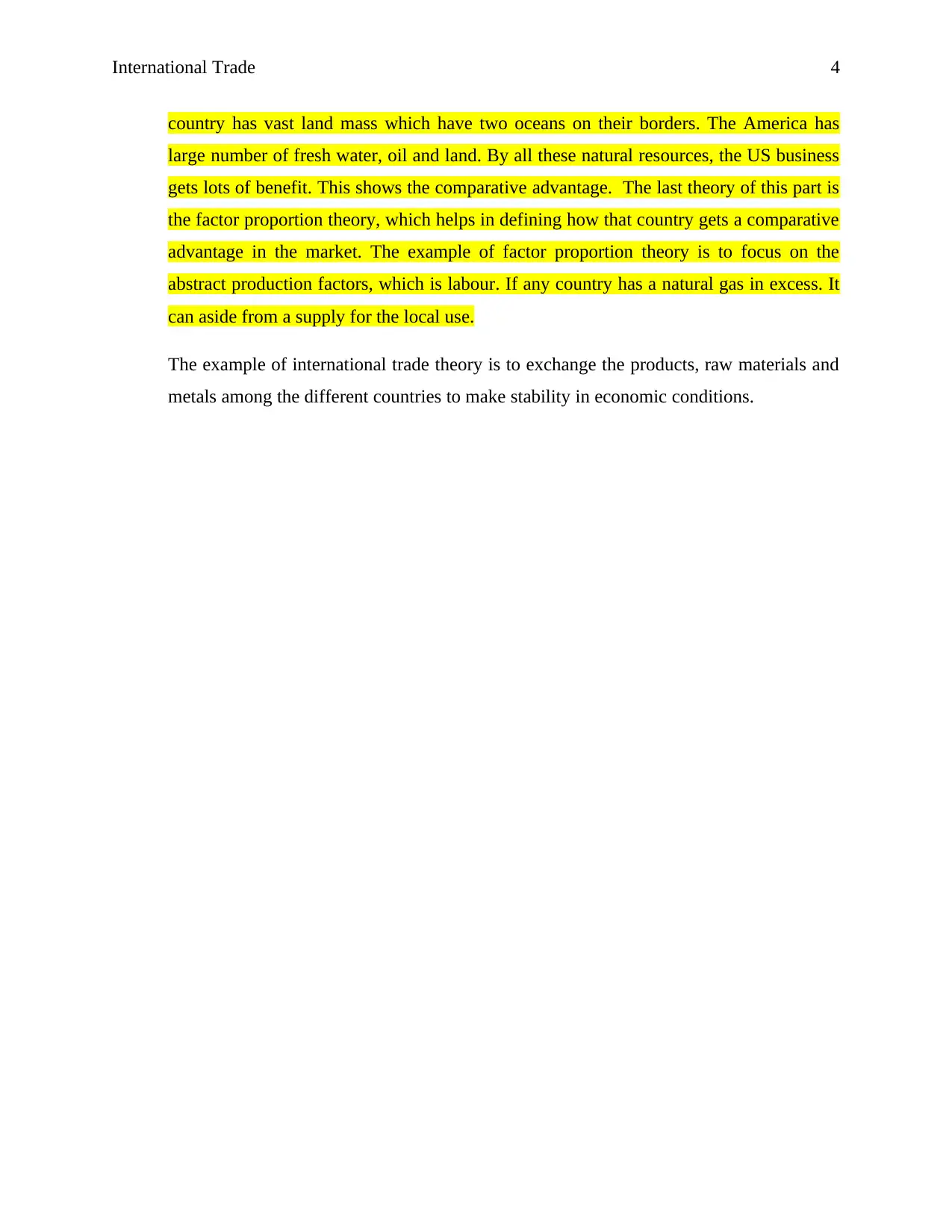
International Trade 4
country has vast land mass which have two oceans on their borders. The America has
large number of fresh water, oil and land. By all these natural resources, the US business
gets lots of benefit. This shows the comparative advantage. The last theory of this part is
the factor proportion theory, which helps in defining how that country gets a comparative
advantage in the market. The example of factor proportion theory is to focus on the
abstract production factors, which is labour. If any country has a natural gas in excess. It
can aside from a supply for the local use.
The example of international trade theory is to exchange the products, raw materials and
metals among the different countries to make stability in economic conditions.
country has vast land mass which have two oceans on their borders. The America has
large number of fresh water, oil and land. By all these natural resources, the US business
gets lots of benefit. This shows the comparative advantage. The last theory of this part is
the factor proportion theory, which helps in defining how that country gets a comparative
advantage in the market. The example of factor proportion theory is to focus on the
abstract production factors, which is labour. If any country has a natural gas in excess. It
can aside from a supply for the local use.
The example of international trade theory is to exchange the products, raw materials and
metals among the different countries to make stability in economic conditions.
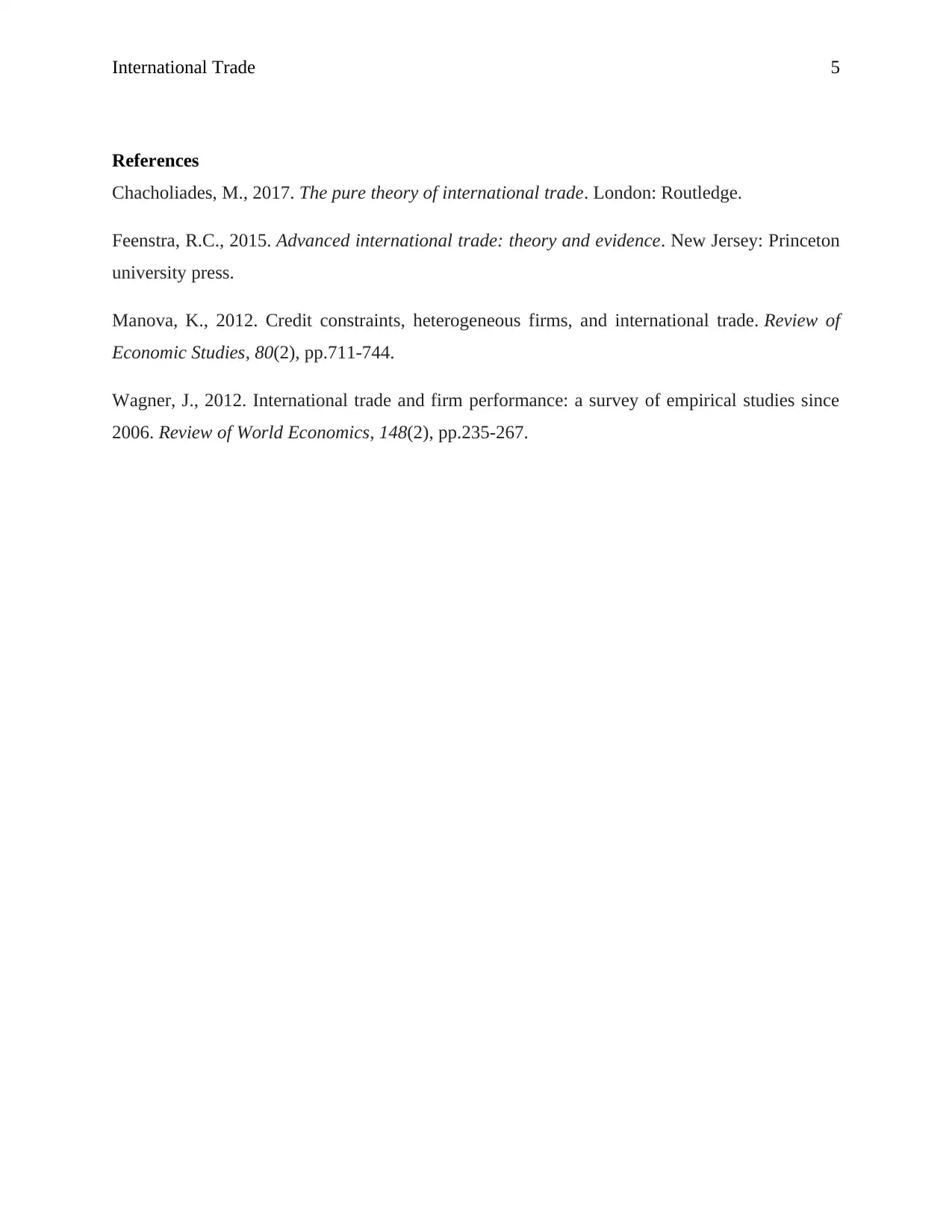
International Trade 5
References
Chacholiades, M., 2017. The pure theory of international trade. London: Routledge.
Feenstra, R.C., 2015. Advanced international trade: theory and evidence. New Jersey: Princeton
university press.
Manova, K., 2012. Credit constraints, heterogeneous firms, and international trade. Review of
Economic Studies, 80(2), pp.711-744.
Wagner, J., 2012. International trade and firm performance: a survey of empirical studies since
2006. Review of World Economics, 148(2), pp.235-267.
References
Chacholiades, M., 2017. The pure theory of international trade. London: Routledge.
Feenstra, R.C., 2015. Advanced international trade: theory and evidence. New Jersey: Princeton
university press.
Manova, K., 2012. Credit constraints, heterogeneous firms, and international trade. Review of
Economic Studies, 80(2), pp.711-744.
Wagner, J., 2012. International trade and firm performance: a survey of empirical studies since
2006. Review of World Economics, 148(2), pp.235-267.
⊘ This is a preview!⊘
Do you want full access?
Subscribe today to unlock all pages.

Trusted by 1+ million students worldwide
1 out of 6
Related Documents
Your All-in-One AI-Powered Toolkit for Academic Success.
+13062052269
info@desklib.com
Available 24*7 on WhatsApp / Email
![[object Object]](/_next/static/media/star-bottom.7253800d.svg)
Unlock your academic potential
Copyright © 2020–2025 A2Z Services. All Rights Reserved. Developed and managed by ZUCOL.




